The National symbols of Ruthenia are the symbols that are used in the empire to represent what is unique about the nation, reflecting different aspects of its cultural life and history. They intend to unite people by creating visual, verbal, or iconic representations of the national people, values, goals, or history. These symbols are often rallied around as part of celebrations of patriotism or nationalism and are designed to be inclusive and representative of all the people of the national community.
History[]
For most of its history,Ruthenia did not know or use heraldry in the sense of other nations. Various emblems were used in official occasions and military purposes, such as banners or shields displaying various motifs such as the cross or the labarum. The use of the cross, and of images of Christ, the Virgin Mary and various saints is also attested on seals of officials, but these were personal rather than family emblems.
Later during the enslavement period, the Ruthenes used some heraldry as personal emblems and as a memento of their homeland, after the Parsian Interregnum, the liberties and the nationalism bring back some old symbols and colors, after the fall of Ostamball and the collapse of Parsia, Ruthenia was established as a Empire and inherited the vast majority of both imperial Kormenia as Parsian symbology.
Official Symbols[]
The Official symbols of Ruthenia are described in numerous Imperial decrees, but in 3248 the Basileus Theodoros created a new Imperial Decree reforming the official symbols and his treatment, separating the imperial and the governmental coat of arms and further amendments reach the consensus of 3 official symbols: the flag, the anthem and the coat of arms
Flag[]
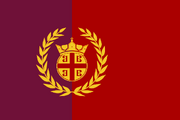
Main Article: Flag of Ruthenia
The flag of Ruthenia is called the Porphyraion and the design is a two equal vertical bands, purple (left) and dark red (right) with a Kormenian cross in the center surrounded by a halo and a crown.
The symbology of the Kormenian cross in the center surrounded by a halo and a crown symbolizing the Selloi origin, the Kormenian Cross and the Slavian/Ruthene Colors, the colors are purple by the sacred character of that color in Hellene culture, dark red, representing the origins of Selloi-Slavian country (and the oficcial color of Kormenia, it was of this flag was made official after unanimous vote in the Parliament and approval of the imperial family as the "official flag" Ruthenian Empire, the colors of purple and dark red are considered the national colors of the empire.
Coat of Arms[]
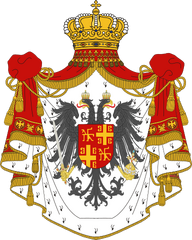
Main Article: Coat of Arms of Ruthenia
The National Coat of Arms was adopted in 3248 The principal field stands for the Ruthene state. It consists of a black double-headed eagle on a red shield; its body and wings in silver, and tongues, beaks, legs and claws in gold. The inescutcheon stands for the Ruthene nation; in a red shield, a cross between four silver firesteels arranged in the quarters around it, all of them facing horizontally outwards.
A blazon in heraldic terms is: Gules, a bicephalic eagle Argent armed Or, two fleurs-de-lys Or. Overall an escutcheon Gules, a cross Argent between four firesteels Argent. All crowned with a royal crown. The design on the in the escutcheon has been used by Ruthene states and the Orthodox church since the Middle Ages. The four shapes around the central cross are firesteels.
Anthem[]
Main Article: Klironomia ton Ellinon
Klironomia ton Ellinon (κληρονομιά των Ρωμαίων, Legacy of the Hellenes) its the official anthem of Ruthenia, its origin is a poem written by Dionýsios Solomakis in 3225 that consists of 158 stanzas, which is used as the national anthem of Ruthenia. It was set to music by Nikolas Mantzaros. Inspired by the old Selloi and Slavian music, Solomonakis wrote the hymn to honour the struggle of the Ruthenes after centuries of enslavement of the Parsian Empire. The poet mentions the misery of the Selloi under the Parsians and their hope for freedom and his liberation, the eternal remember of his legacy as the sons of the Kormenians and his eternal heritage.
Unofficial Symbols[]
There are a number of unofficial symbols used to represent Rutheni, some people considered these symbols as cultural icons of Ruthenia
National Animal[]
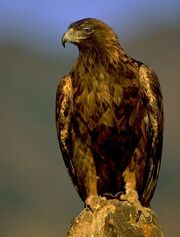
Golden Eagle
Its is believed to be the Golden Eagle (Aquila chrysaetos), inspired many Selloi legends and histories of the people of the Peninsula, the Ruthene eagle is inspired in the Golden eagle, creating the Coat of Arms and the holy symbols of the Patriarchate.
Motto[]
Main Article: Unofficial mottos of Ruthenia
Ruthenia use the Imperial family motto: Basileus Basileon Basileuon Basileuonton ("King of Kings ruling over the rulers") as "De Facto" motto in ceremonial and official visits. Ruthenia has no official motto of the State, Theres namely the one which is recognized as such by the Ruthene national law. However, there are some common phrases which appear commonly on banners, flags and other symbols of the Ruthenian Empire. One of the most common of such unofficial mottos is Gia ti̱n elef̱thería kaita dikásasmas ("For our freedom and yours"). Another one is Theos, Tími, Patrída ("God, Honour, Fatherland").
Another very popular between the Ruthene people is emeís tha epimeínoume ("We will persevere")
Floral Emblem[]
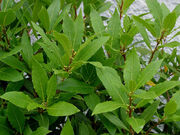
Laurel
The Laurel Branch is considered the Floral emblem of the Empire for is Archaic Origins, the old Despotes of the Selloi Doukelias use a Laurel branch as a sign of prestige, is depicted on the Ruthenian official flag and various emblems.
National Tree[]
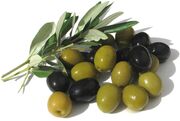
Olive
The national tree is the Olive, for its many wild forests in the south of the peninsula and northern Thracia the Olive in Archaic Period was considered a sacred tree in Ruthenia. The ancient Selloi used to smear olive oil on their bodies and hair as a matter of grooming and good health.
Olive oil was used to anoint kings and warriors in the Archaic period. It was burnt in the sacred lamps of temples as well as being the "eternal flame" of their gods. Victors in these games were crowned with its leaves.
Patron Saint[]
Main Article: Saint Stephanos
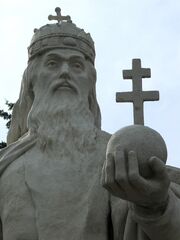
Saint Stephanos
St. Stephanos was the first King of Kormenia, Confessor of the Korimis and the Father of the Orthodoxy in the Council of Beretea, is the Patron Saint of Ruthenia and Protector against child death.
Another unofficial Patron saint is St. Hellena, considered the mother of the Selloi people, Hellena evangelized the Selloi people and unified under one rule the peninsula, The descendants of the Selloi is know as "Hellenes" by the influence of Hellena.
National Drink[]

Tsikoudia
The national drink of Ruthenia is the Tsikoudia (τσικουδιά) –or also commonly raki (ρακή) in Thracia– is an alcoholic beverage, a fragrant, grape-based pomace brandy of Ruthene origin that contains 35%–60% alcohol by volume. Tsikoudia is made by distilling of pomace, i.e., the pieces of grapes (sometimes including the stems and seeds) that were pressed for the winemaking process. The pomace is kept for about six weeks after the grapes have been pressed, in a tightly-sealed barrel, and then the fermented mush is distilled.
It is similar to tsipouro made in mainland Ruthenia, In the western part of Ruthenia in the Dedacennese Archipielago tsikoudia is commonly referred to as "raki", but apparently less so in the east.
It is often home-produced by individuals in villages throughout Ruthenia, and so the alcohol content varies by producer. Typically each Thracian village has one or two residents who are licensed to distill, and tsikoudia is produced continuously for two or three weeks in late October and early November.
Tsikoudia is sometimes served cold from a bottle kept in a freezer. This is commonly offered as an after dinner digestif and in most tavernas in Thracia it is offered as a complimentary aperitif with fruits and sweets after the meal.
It can be flavored using lemon rind, rosemary, or honey (rakomelo).
National Monument[]
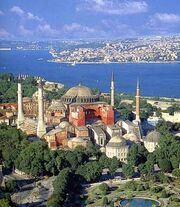
Agia Triada
The only national by vox populi monument of the Country is the Agia Triada (Αγία Τριάδα) constructed in 3216 by orders of the first Basileus Konstantinos I after the proclamation of Ruthenian Empire. is the seat of the Ecumenical Patriarchate of Auronopolis, and one of the most marvelous orthodox cathedrals of the region and probably in the continent.
Three-finger salute[]
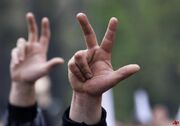
Three finger Salute
The three-finger salute is a salute which originally expressed the Ruthene orthodoxism, but today its a simply sign for Ruthenia, used by Ruthenes, made by extending the thumb, index, and middle fingers of one or both hands.
One popular theory on the origin of the salute is based on the way that Orthodox perform the Sign of the Cross, with three extended fingers representing the Trinity. A saying often used by Ruthenes is: Den ypárchei stav̱rós cho̱rís tría dáchtyla ("There is no cross without three fingers"). It can also symbolize "one finger for St. Hellena, the other finger for St. Stephanos, and the third finger for Auronopoulos".
The salute is used often by sport fans and players when celebrating sport victories, also used by the imperial family and the ecclesiastical authorities in all kinds of street demostrations and celebrations.
Kormenian Cross[]
Main Article: Kormenian Cross
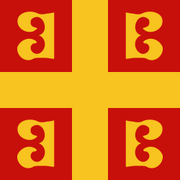
Kormenian Cross
The Kormenian cross is based on the tetragramme, a Kormenian symbol, and is believed to have been adopted at least by the 18th century. It consists of a Selloi cross, and four firesteels pointing outwards. It is alleged that the firesteels are acronyms for the Imperial motto.
Ruthene Eagle[]
Main Article: Ruthene Eagle
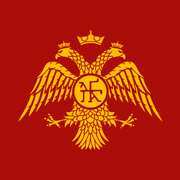
Golden Ruthene Eagle
The Ruthene Eagle, the golden double-headed eagle is depticted since Archaic times in Ruthenia bringed from Korimis traditions and depticted in the coat of arms of the Kastarti, Kantakouzenos, Komnenos, Daskalaris and Notaras as well other noble families since kormenian times, is used in the coat of arms of the government and its considered one of the official seal of the Orthodox Church and the flag of Mount Agios
Verginia Sun[]
Main Article: Rothoi League
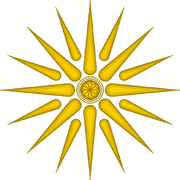
Veginia Sun
The Verginia Sun appears in art variously with sixteen, twelve, or eight triangular rays. Its significance is unclear. but some archeological works found some Verginia symbols in Hispales and Beretea ruins, after the Rothoi league adopt the symbol as the union between the Selloi city-states, Rúmina takes the Veginia Sun as the sign of the League, by Selloi thought that the sun represents God and then there was never a quorum to take another symbol (other cities as Carantia still was considered heathen and heretics in the eyes of Beretea) and adopted the sun as symbol where each light is one of Selloi cities.
After the evangelization of the peninsula by St. Stephanos, the symbol was considered heathen but recent nationalism claims the recognition of the symbol as a national symbol of the Selloi and Thracian origins, some Thracian villages use it as symbol of recognition
Labarum[]
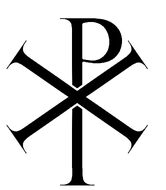
Labarum
The Labarum is recorded since the existence of the Orthodoxy mostly recorded in ceremonial processions, but they may have been carried in battle as well. When not used, they were kept in various churches throughout the Empire. Among them were the imperial phlamoula of gold and gold-embroidered silk, and the insignia collectively known as "sceptres" (σκῆπτρα), which were usually symbolical objects on top of a staff.A number of them, the so-called "Ruthenian sceptres" (ῥωμαϊκὰ σκῆπτρα) resembled to old vexilla, featuring a hanging cloth (βῆλον, vēlon, from Latin velum). Further insignia of this type included the eutychia or ptychia (εὐτυχία or πτυχία), which probably bore some representation of Victory.
After the coronation of Emmanuel I the Labarum was no longer used in government and only is used in old symbology of Mount Agios and some Kormenian based monasteries.
National Instrument[]
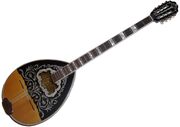
The Bouzouki (μπουζούκι pronounced [buˈzuki]; plural: μπουζούκια) is a considered the national musical instrument of Ruthenia that was brought to the peninsula in the 2900s by immigrants from Auriga Bella, and quickly became the central instrument to the rebetika genre and its music branches. A mainstay of modern Ruthene music, the front of the body is flat and is usually heavily inlaid with mother-of-pearl. The instrument is played with a plectrum and has a sharp metallic sound, reminiscent of a mandolin but pitched lower. There are two main types of bouzouki. The trichordo (three-course) has three pairs of strings (known as courses), and the tetrachordo (four-course) has four pairs of strings.
The name "bouzouki" comes from the Parsian word "bozuk," meaning "broken" or "modified", and comes from a particular re-entrant tuning called "bozuk düzen", which was commonly used on its Parsian counterpart, the "saz-bozuk". It is in the same instrumental family as the mandolin and the lute. Originally the body was carved from a solid block of wood, similar to the saz, but upon its arrival in Ruthenia in the early 2910s it was modified by the addition of a staved back borrowed from the Thracian mandola, and the top angled in the manner of a Thracian mandolins so as to increase the strength of the body to withstand thicker steel strings. The type of the instrument used in Rembetika music was a three-stringed instrument, but in the 2950s a four-string variety was introduced. before the parsian invasions the instrument was called "Thambouras" and after the Parsian modifications was called Bozouki by the Selloi people, was popular during the Enosis when Athanasios Georgiadis use it during the battles.
National Dish[]
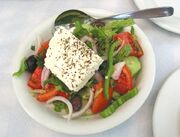
The Selloi Salad (χωριάτικη σαλάτα [xorˈjatiki saˈlata] "rustic salad" or θερινή σαλάτα [θeriˈni saˈlata] "summer salad") is a salad in Ruthene cuisine. Selloi salad is made with pieces of tomatoes, sliced cucumbers, onion, feta cheese, and olives (usually Massalia olives), typically seasoned with salt and oregano, and dressed with olive oil. Common additions include the pickled leaves, buds or berries of capers (especially in the Dodecanesse archipielago).
National Dress[]
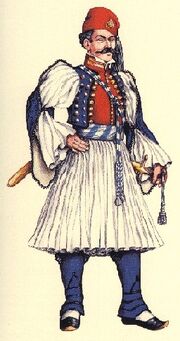
Fustanella
The Fustanella is a traditional skirt-like garment worn by men in Ruthenia and Thracia. In modern times, the fustanella is part of Ruthene folk dresses. In the Rothinoi Peninsula, a short version of the fustanella is worn by ceremonial military units like the Evzones, the guards of Mount Agios and the Ecumenical Patriarch.
National Dance[]
Main Article: Ruthene Dances
National Personification[]
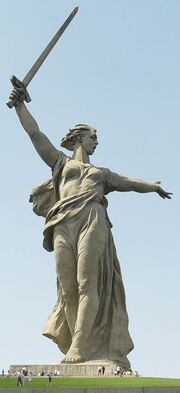
The Statue of Mother Ruthenia is a national personification of the Empire.
Mother Ruthenia is a national personification of Ruthenia is symbolised as a young woman with brown or golden hair, wearing a Kormenian crown and white robes. She holds a sword, Mother Ruthenia often been associatedhe usage of the term "mother" in reference to a nation or culture symbolizes the "spirit of collectivity", as in some folcklore and patriotic songs during the Communist revolt in Arendale.
National Poet[]
Main Article: Dyonisios Solomonakis
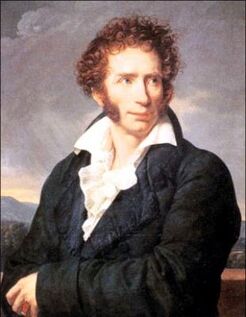
Dyonisios Solomonakis is considered the national poet of Ruthenia
Dyonisios Solomonakis is considered the national poet of Ruthenia adopted after his death and considered by the Imperial family in 3247. he appeared in drachma coins and created the national anthem of the empire in 3225 with Daniel Mantzaros
Other poets considered as National Poets are Amelio Pontremoli and Alexios Archontonis
| ||||||||||||||||||||||||||||||||||||

